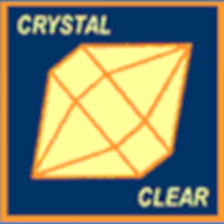Scintillating materials are used in high energy and nuclear physics, astrophysics, medical imaging, non destructive testing, security devices, geological surveys, and a number of other industrial applications.
The Crystal Clear collaboration was set up in 1990 and registered as RD-18 by the CERN DRDC committee. The main objective of this project was to develop scintillating materials, which would be suitable for use at the LHC collider. Indeed, none of the existing scintillators at that time had the appropriate characteristics for use in the extremely demanding LHC application.
To achieve this goal, the Crystal Clear collaboration set up an interdisciplinary network involving world experts in different aspects of material science (crystallography, solid state physics, luminescence, defects in solids) and experts in instrumentation for the detection of high energy photons and electrons.
The Crystal Clear collaboration has been quite successful. On the basis of our studies, the CMS collaboration decided in 1994 to choose a detector based on the use of PbWO4 scintillator for the electromagnetic calorimeter.
The Crystal Clear collaboration at the same time succeeded to create and motivate a community of scientists to develop a new field of applied research on the physics of scintillation processes in solids. This attracted scientists and engineers from other areas using scintillating materials, which resulted in a world wide community of about 250 scientists who meet every two years at the SCINT conference.
Among the achievements of Crystal Clear, we should mention:
- From 1990 to 1994, Crystal Clear made an intensive investigation for the quest of the most adequate ideal scintillator for the LHC; three main candidates were identified and extensively studied: CeF3, PWO (PbWO4) and heavy scintillating glasses. Lead tungstate was chosen by CMS and ALICE as the most cost-effective crystal compliant to LHC conditions. Today, 76648 PWO crystals are installed in CMS and 17920 in ALICE.
- Since 1994, new crystals such as YAP, LuAP (Petrosyan and BTCP) and LuAG (Petrosyan, Crytur) started to be developed.
- Since 1998, several novel medical imaging devices based on scintillating crystals (LuAP, LuYAP, LSO, LYSO) were developed: ClearPET, ClearPEM, ClearPEM-Sonic, EndoTOFPET, EndoTOFPET-US
- Since 2007, work has been undertaken on the enhancement of light yield LY (crystal photonic) and understanding of timing properties of crystal (FAST Cost Action).
- Since 2008, there has been ongoing activities on the production of new crystals with novel techniques for particle physics in particular crystal fibers.
-
Since 2015, scintillators based on nano materials entered our research focus.
Crystal Clear spokespersons have been:
- Dr. Paul Lecoq (1991-1995)
- Pr. Stefan Tavernier (1995-2010)
- Dr. Etiennette Auffray (2010- )
